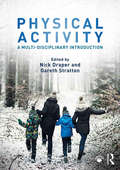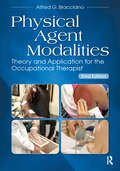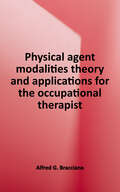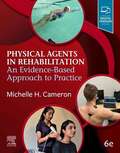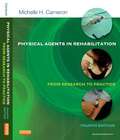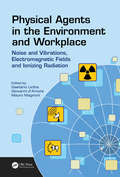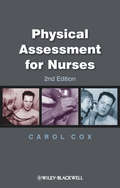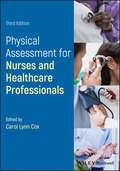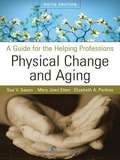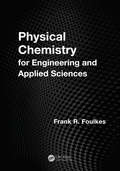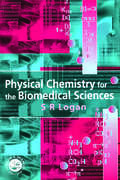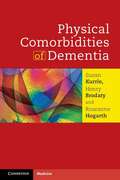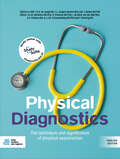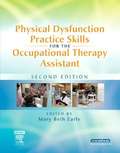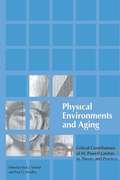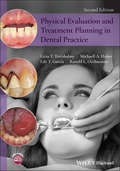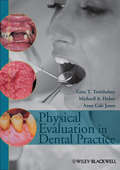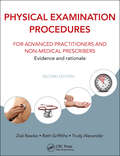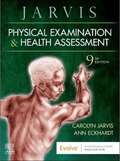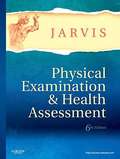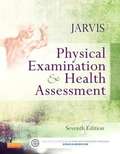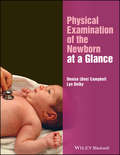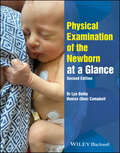- Table View
- List View
Physical Activity: A Multi-disciplinary Introduction
by Nick Draper Gareth StrattonPhysical activity and its relationship to health is one of the great issues of our age. The causes of, and solutions to, physical inactivity are complex and multi-dimensional, and therefore the subject needs to be studied and understood from a variety of perspectives. This is the first textbook to provide a truly multi-disciplinary introduction to physical activity studies. Offering a complete foundation to the subject, it covers the basics of every core discipline from biochemistry, public health and biomechanics to physiology, sport psychology and sociology. It introduces a full range of topics across the physical activity curriculum, including behaviour change, motor skill development, nutrition, exercise prescription, public health policy, and physical education, providing a well-balanced and international perspective on each important issue. There is also a strong emphasis throughout the book on the practical, applied dimensions of physical activity, including innovative approaches to promotion and intervention tailored to every age range and environment. Physical Activity: A Multi-disciplinary Introduction is an indispensable companion to any course or degree programme with an emphasis on physical activity and health. A variety of exclusive eResources to aid teaching and learning are also available via the Routledge website.
Physical Agent Modalities: Theory and Application for the Occupational Therapist
by Alfred BraccianoThe popular occupational therapy textbook Physical Agent Modalities: Theory and Application for the Occupational Therapist has been newly updated and revised into a comprehensive Third Edition. Using current occupational therapy terminology and philosophy, this text establishes the theoretical basis and clinical reasoning for the use of physical agent modalities in practice. The biophysiological effects of the modalities are identified and discussed alongside their impact on function and performance. Relevant to both students and practitioners, the Third Edition educates on the proper, safe, and judicious use of physical agent modalities while treating clients.Written by Dr. Alfred G. Bracciano, this book outlines the application procedures for each modality, indications for their use, and the precautions and contraindications of the modality.New to the Third Edition: Organizational boxed asides and tables related to each concept area Evidence-based research boxes and tables related to clinical reasoning case studies New chapters on physiological impact of interventions, soft tissue techniques, and health care reform Global perspective providing a resource for the international therapist New color flow charts and improved graphics Each chapter contains: Learning objectives Key terms Case studies Included with the text are online supplemental materials for faculty use in the classroom.With up-to-date information and new chapters, Physical Agent Modalities: Theory and Application for the Occupational Therapist, Third Edition provides a user-friendly, organized reference ready to be applied in the clinical setting.
Physical Agent Modalities: Theory and Application for the Occupational Therapist
by Alfred G. BraccianoThis popular occupational therapy textbook has been newly updated and revised into a comprehensive Third Edition. Using current occupational therapy terminology and philosophy, this text establishes the theoretical basis and clinical reasoning for the use of physical agent modalities in practice. The biophysiological effects of the modalities are identified and discussed alongside their impact on function and performance. Relevant to both students and practitioners, the Third Edition educates on the proper, safe, and judicious use of physical agent modalities while treating clients. This book outlines the application procedures for each modality, indications for their use, and the precautions and contraindications of the modality.
Physical Agents In Rehabilitation: An Evidence-Based Approach to Practice
by Michelle H. CameronLearn how to select and apply physical agents to optimize patient outcomes! Physical Agents in Rehabilitation, 6th Edition provides evidence-based guidance for safe and effective use of agents such as heat and cold, lasers and light, ultrasound, electrotherapy, shock waves, hydrotherapy, traction, and compression. It makes clinical decision making easier with clear explanations of the scientific theory and physiology underlying each agent, and also describes current research and rationales for treatment recommendations.
Physical Agents in Rehabilitation: From Research To Practice
by Michelle H. CameronPresenting a variety of treatment choices supported by the latest clinical research, Physical Agents in Rehabilitation: From Research to Practice, 4th Edition is your guide to the safe, most effective use of physical agents in your rehabilitation practice. Coverage in this new edition includes the most up-to-date information on thermal agents, ultrasound, electrical currents, hydrotherapy, traction, compression, lasers, and electromagnetic radiation. Straightforward explanations make it easy to integrate physical agents into your patients' overall rehabilitation plans.
Physical Agents in the Environment and Workplace: Noise and Vibrations, Electromagnetic Fields and Ionizing Radiation
by Gaetano Licitra, Giovanni d’Amore and Mauro MagnoniThis book explores environmental physical agents and their potential effect on public and occupational health. It considers the theory, current research, and applications of physical agents including noise, ionizing radiation protection and non ionizing radiation protection, and explores the monitoring, measurement, modeling and mitigation of each of these. Features: Covers all three physical agents in one comprehensive book Presents the latest results from research, as well as theory Contributed to by a panel of international experts
Physical Assessment for Nurses
by Carol CoxThe fully updated second edition of this book continues to take a systematic approach to comprehensive patient assessment. The text explores best practice in history taking and summarises the key clinical skills needed to develop and improve physical examination skills and to competently assess, diagnose, plan and provide care.
Physical Assessment for Nurses and Healthcare Professionals
by Carol Lynn CoxPhysical Assessment for Health Care Professionals offers a practical and comprehensive guide to best clinical practice when taking patient history and physical examination. This accessible text is structured in accordance with the competencies for advanced practice in assessment, diagnosis and treatment as published by the RCN. Following a systematic, systems-based approach to patient assessment, it includes a summary of the key clinical skills needed to develop and improve clinical examination in order to confidently assess, diagnose, plan and provide outstanding care. In this revised edition, colour photographs and case studies have been included to assist health care practitioners in their assessment of the patient. This important guide: Includes a highly visual colour presentation with photographs and illustrations. Features a wide range of key learning points to help guide practice. Offers illustrative examples, applications to practice and case studies. Is available in a range of digital formats – perfect for ‘on the go’ study and reference. Written for health care students, newly qualified and advanced nurse practitioners, and those in the allied health professions, Physical Assessment for Health Care Professionals is the essential guide for developing the skills needed to accurately access patient history and physical examination.
Physical Biology of Proteins and Peptides
by Luis Olivares-Quiroz Orlando Guzmán-López Hector Eduardo Jardón-ValadezThis book covers the latest developments in the physical biology of proteins and peptides. Key insights into microscopic and macroscopic approaches to describe biologically relevant macromolecules and their interactions are provided. This book also covers a wide range of tools, including theoretical methods as statistical mechanics, normal mode analysis, kinetic theory and stochastic processes, and all-atom and coarse-grained molecular dynamics simulations. New experimental techniques are also discussed, particularly related to amiloidogenic peptides and their mutations. This is an excellent book for molecular biologists, physicists, computational scientists, and chemists. It covers cutting-edge research in this exciting, interdisciplinary research field. This book also: Discusses the latest developments in the physical biology of proteins, peptides and enzymes covering theoretical, computational, and experimental approaches Broadens readers' understanding on the role of intra- and inter-molecular interactions as a fundamental cornerstone of macroscopic biological properties of macromolecules Provides a wide and useful perspective on different aspects of the physics, biology, and chemistry of proteins and peptides suitable for interdisciplinary research.
Physical Change and Aging: A Guide for the Helping Professions (5th edition)
by Sue V. Saxon Mary Jean Etten Elizabeth A. PerkinsAlthough this book focuses primarily on physical changes and the common pathologies associated with aging, it also considers the psychological and social implications of such changes for human behavior. Since aging is a complex process, it is impossible to consider biological or physical aspects without a comparable concern for the psychological, emotional, and social factors involved.
Physical Chemistry for Engineering and Applied Sciences
by Frank R. FoulkesPhysical Chemistry for Engineering and Applied Sciences is the product of over 30 years of teaching first-year Physical Chemistry as part of the Faculty of Applied Science and Engineering at the University of Toronto. Designed to be as rigorous as compatible with a first-year student's ability to understand, the text presents detailed step-by-step
Physical Chemistry for the Biomedical Sciences
by S.R. LoganThis is an introductory text for students which will bring them up to speed ready for first-year university level physical chemistry. The text begins by looking at atoms and their structure, and goes on to study different phases of matter and relates them to forces acting between molecules. As the book progresses, it analyses both phase and chemical equilibria, energy and kinetics, and the final section is about reactive free radicals.
Physical Comorbidities of Dementia
by Susan Kurrle Henry Brodaty Roseanne HogarthDementia is reaching epidemic proportions. To date treatment has focused on cognitive and behavioural symptoms and their management, but the physical side has been neglected. Physical comorbidity is extremely common in people with dementia and leads to excess disability and reduced quality of life for the affected person and their family. Physical comorbidity is often treatable if not reversible. Epilepsy, delirium, falls, oral disease, malnutrition, frailty, incontinence, sleep disorders and visual dysfunction are found to occur more frequently in dementia sufferers. Physical Comorbidities of Dementia describes how these may present and gives detailed information and evidence-based recommendations on how to recognise and manage these conditions. Written by clinicians, each chapter deals with a separate condition accompanied by a list of recommendations for management. Physical Comorbidities of Dementia provides practical explanations and solutions to help all healthcare professionals to improve care for people with dementia.
Physical Diagnostics: The technique and significance of physical examination
by H.E.M. Daelmans T.O.H. de Jongh F.J. Jongen-Hermus I. de Klerk-van der Wiel B.J.J.W. Schouwenberg J. Damen R. Franssen A. D. Pieterse F. SchuringPhysical examination, along with history-taking, forms the basis of diagnosis. Interpretation of the information obtained will determine whether further diagnostic tests are worthwhile, and if so, which ones. This book provides students, lecturers and practising doctors with a standard for physical examination. Physical Diagnostics describes physical examination systematically. The relevant anatomy and physiology are set out, as these provide the basis for the proper technique of physical examination. The book also provides information on normal and abnormal findings and their clinical significance. In addition to the systematic descriptions of adult examination there are chapters on the physical examination of specific groups such as pregnant women, newborn babies, children and geriatric patients. Videos of all the procedures described have been made, over 150 clips in total. These can be viewed in the StudySuite online learning environment, where audio clips and the text of the book can also be found. StudySuite enables readers to switch easily between the videos and the text. This new edition has been reorganized so as to make a clear distinction between general examination and examination on indication. There are new chapters on mental state examination, general physical examination in adults and chapters containing guidelines for communication and hygiene during physical examination. The text has been brought up to date and augmented where necessary, and many new illustrations have been included. There is a checklist for each chapter setting out the content of physical examination schematically. Physical Diagnostics is intended primarily for medical students, specialist nurses and trainee medical specialists to learn physical examination systematically. It will also be found useful by doctors, lecturers and paramedical practitioners wishing to update and refresh their knowledge regarding the proper technique of physical examination and the clinical significance of abnormal findings. The book has been produced in collaboration between the eight Dutch University Medical Centres and faculties, with input from Belgian colleagues.
Physical Dysfunction Practice Skills For The Occupational Therapy Assistant
by Mary Beth EarlyAimed at students training to become occupational therapy assistants, this textbook teaches key techniques designed to help patients to participate in personally selected and valued occupations. It is assumed that students have already completed basic anatomy and physiology and foundation OT courses. The second edition has been revised to conform to the AOTA's Occupational Therapy Practice Framework.
Physical Environments and Aging: Critical Contributions of M. Powell Lawton to Theory and Practice
by Paul Windley Rick ScheidtA tribute and guide to M. Powell Lawton's groundbreaking work! Dr. M. Powell Lawton, who died in January 2001, was arguably the most significant thinker, researcher, and practitioner in environment-behavior studies within the field of gerontology. The authors of Physical Environments and Aging represent three generations of internationally recognized researchers whose lives and work were greatly influenced by both Lawton the professional and Lawton the man. This book presents their assessment of his contributions to environmental theory, purpose-built housing, community study, long-term care settings, and other related topics. Many of the contributors also share personal anecdotes that illustrate how Lawton's professional visions were shaped by his remarkable intellect and personality. Physical Environments and Aging examines many aspects of environmental gerontology, including: housing policy reform and home modification place therapy philosophic foundations of environment-aging studies the future of theory, practice, and policy in the field the role of neighborhoods More than just an homage, Physical Environments and Aging is also a practical guide to the field, offering you tractable theory, useful methods and measures, and functional research overviews in the realms of everyday experience of older adults.
Physical Evaluation and Treatment Planning in Dental Practice
by Géza T. Terézhalmy Michaell A. Huber Lily T. García Ronald L. OcchioneroThe revised Second Edition of Physical Evaluation and Treatment Planning in Dental Practice has been expanded to include information pertinent when considering comprehensive treatment planning for a wide variety of dental procedures. Written by internationally recognized specialists and discipline experts in their field, the Second Edition offers new chapters on dental and oral diseases and disorders, including insights and diagnostics for each category. Readers will learn about diagnosis and planning considerations for orofacial pain, caries, periodontics, oral surgery, endodontics, restorative, prosthodontics and esthetic dentistry, and more. Beginning with a complete introduction of oral health and associated systemic health, the book incorporates discussions of patient history profiles, basic procedures in physical examinations, including examination of the head, neck, extraoral and intraoral tissues, radiographic examination and interpretation, as well as laboratory methods. Readers will also find: A thorough introduction to the orofacial clinical processes, including the essential phases in treatment, quality management, patient-doctor communication, documentation, and management of critical patient information. An exploration of basic procedures in physical examinations in dentistry, including inspection, palpation, percussion, auscultation, olfaction, and evaluation of function, form, and detailed analysis. A thorough review of the head and neck complex. An analysis of the examination and diagnosis of the intraoral and extraoral features, including all hard and soft tissues of the orofacial complex. Designed for general dental practitioners, periodontists, prosthodontists, dental residents and fellows, and dental students, Physical Evaluation and Treatment Planning in Dental Practice is a logically organized one-stop reference for patient evaluation and treatment.
Physical Evaluation in Dental Practice
by Géza T. Terézhalmy Michaell A. Huber Anne Cale JonesPhysical Evaluation in Dental Practice introduces the general concepts of physical evaluation, teaching essential skills and values in patient care and offering a quick reference to common problems of the head and neck. This practical clinical guide provides concise, illustrated synopses of the manifestation of common diseases and conditions in the mouth, head, and neck. Offering the practicing dentist a solid grounding in patient examination, evaluation, and diagnosis, Physical Evaluation in Dental Practice is an invaluable chair-side reference aimed at predoctoral dentists, dental hygiene students, practicing dentists, and hygienists.
Physical Examination Procedures for Advanced Practitioners and Non-Medical Prescribers: Evidence and rationale, Second edition
by Zoë Rawles Beth Griffiths Trudy AlexanderThis revision and quick-reference guide provides evidence-based information on physical examination procedures for advanced nurses and independent prescribers. A step-by-step checklist for each body system is presented alongside a rationale to aid understanding and reinforce learning. Case studies help put the information into context and links to further discussion enable readers to determine which techniques to use as well as to justify the way they perform each examination.
Physical Examination and Health Assessment
by Carolyn Jarvis Ann L. EckhardtWith an easy-to-follow approach and unmatched learning support, Jarvis's Physical Examination and Health Assessment, 9th Edition is the most widely used, authoritative, complete, and easily implemented learning solution for health assessment in nursing. This hub of a tightly integrated learning package continues to center on Carolyn Jarvis's clear, logical, and holistic approach to physical examination and health assessment across the patient lifespan. It's packed with vivid illustrations, step-by-step guidance, and evidence-based content to provide a complete approach to health assessment and physical examination. With an enhanced focus on today's need-to-know information, the 9th edition integrates concepts from the Quality and Safety Education for Nurses (QSEN) initiative, concepts of interprofessional collaboration, enhanced transgender considerations, and integrated content and electronic resources for success on the Next Generation NCLEX®.
Physical Examination and Health Assessment (6th Edition)
by Carolyn JarvisWith an easy-to-read approach and unmatched learning support, Physical Examination and Health Assessment, 6th Edition offers a clear, logical, and holistic approach to physical exam across the lifespan. Detailed illustrations, summary checklists, and new learning resources ensure that you learn all the skills you need to know. This gold standard in physical exam reflects what is going on in nursing today with coverage of emerging trends and new evidence-based content.
Physical Examination and Health Assessment (Seventh Edition)
by Carolyn JarvisPhysical Examination & Health Assessment is a text for beginning students of physical examination as well as a text and reference for advanced practitioners. The 7th edition has a new chapter section and several new content features.
Physical Examination for Surgeons
by Gogalniceanu, Petrut and Pegrum, James and Lynn, William Petrut Gogalniceanu James Pegrum William LynnPhysical examination is a key element of clinical diagnosis in surgical practice, as well as an essential skill in postgraduate professional entry and exit examinations. With its 'at-a-glance' algorithms, mind maps, and exam-style questions and answers, Physical Examination for Surgeons provides a concise yet authoritative guide to examination technique and differential diagnosis. Written by a team of senior surgical registrars and consultant surgeons, experienced postgraduate examiners and leading international experts, it provides a comprehensive and definitive answer to the challenges of the MRCS exam on physical examination. All surgical specialties are covered, including neurosurgery, ENT, gynaecology and transplant. It is a high-yield revision aid for the Membership of the Royal College of Surgeons exam, as well as a valuable reference for the Fellowship exam (FRCS) and beyond. Of interest to trainee and practising surgeons, emergency medicine physicians, medical students and clinical nurse specialists and military healthcare practitioners.
Physical Examination of the Newborn at a Glance (At a Glance (Nursing and Healthcare))
by Denise Campbell Lyn DolbyPhysical Examination of the Newborn at a Glance provides a comprehensive guide for all those involved with both the routine neonatal examination and the more specific full physical examination of a newborn. Covering the routine care and the competencies required to perform the examination of the newborn as set out by the Newborn and Infant Physical Examination (NIPE) Screening Programme, this beautifully illustrated book encourages the critical appraisal of personal and practice standards relating to the examination of the newborn in order to promote effective and high quality holistic care of the family unit. Encapsulating the learning requirements across a pre and post-registration audience, Physical Examination of the Newborn at a Glance is an indispensable resource for those beginning their journey to become a NIPE practitioner, as well as those who are looking to update their professional knowledge and understanding.
Physical Examination of the Newborn at a Glance (At a Glance (Nursing and Healthcare))
by Denise Campbell Lyn DolbyThe market‐leading at a Glance series is popular among healthcare students and newly qualified practitioners for its concise, simple approach and excellent illustrations. Each bite‐sized chapter is covered in a double‐page spread with clear, easy‐to‐follow diagrams, supported by succinct explanatory text. Covering a wide range of topics, books in the at a Glance series are ideal as introductory texts for teaching, learning and revision, and are useful throughout university and beyond. Everything you need to know about Physical Examination of the Newborn… at a Glance! Physical Examination of the Newborn at a Glance provides clear and comprehensive guidance for all those involved with both routine neonatal examination and more specific full physical examinations. Throughout the book, readers are encouraged to critically assess their personal and practice standards relating to the examination of the newborn to promote effective and high-quality holistic care of the family unit. The second edition of Physical Examination of the Newborn at a Glance is revised to reflect current practice and the Newborn Infant Physical Examination (NIPE) standards. New and expanded chapters address bed sharing, chromosomal abnormalities, neonatal adaptation, referral pathways, health promotion, issues encountered in professional practice, and more. This guide: Presents a thorough account of appropriate physical examination of the newbornExplores the theoretical and practical issues readers may experience in practiceIntegrates colourful images and text to appeal to visual and non-visual learners alikeIncludes multiple-choice questions and self-assessment exercises Physical Examination of the Newborn at a Glance, Second Edition, remains a must-have study or revision guide for undergraduate midwifery and nursing students, newly qualified NIPE practitioners in need of a reliable quick-reference guide, and experienced professionals wanting to update their knowledge and understanding. All content reviewed by students for students Wiley Health Science books are designed exactly for their intended audience. All of our books are developed in collaboration with students. This means that our books are always published with you, the student, in mind. If you would like to be one of our student reviewers, go to www.reviewnursingbooks.com to find out more. This title is also available as an e-book. For more details, please see www.wiley.com/buy/9781394277032
